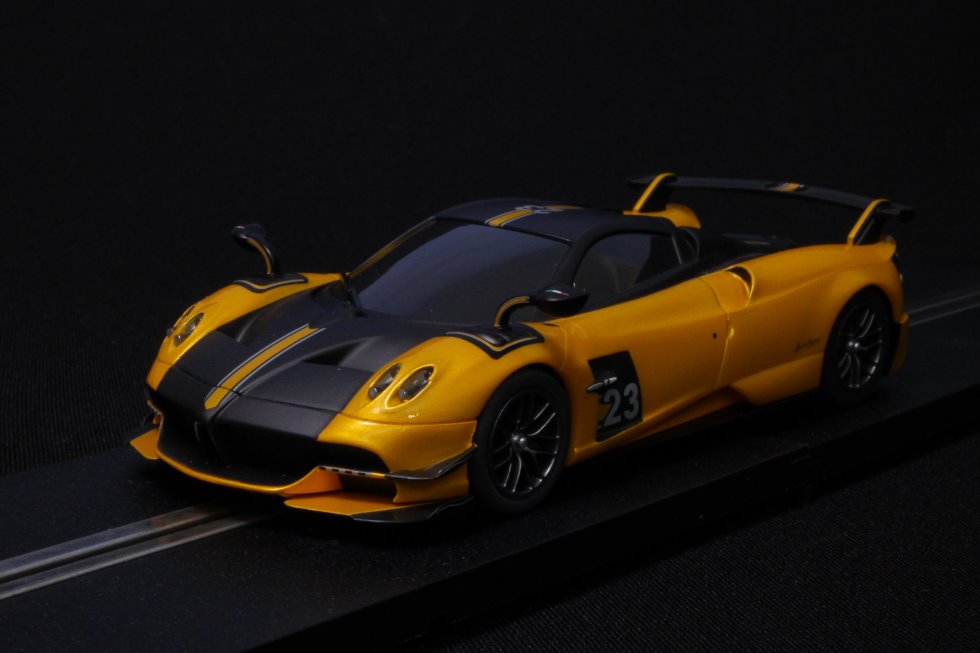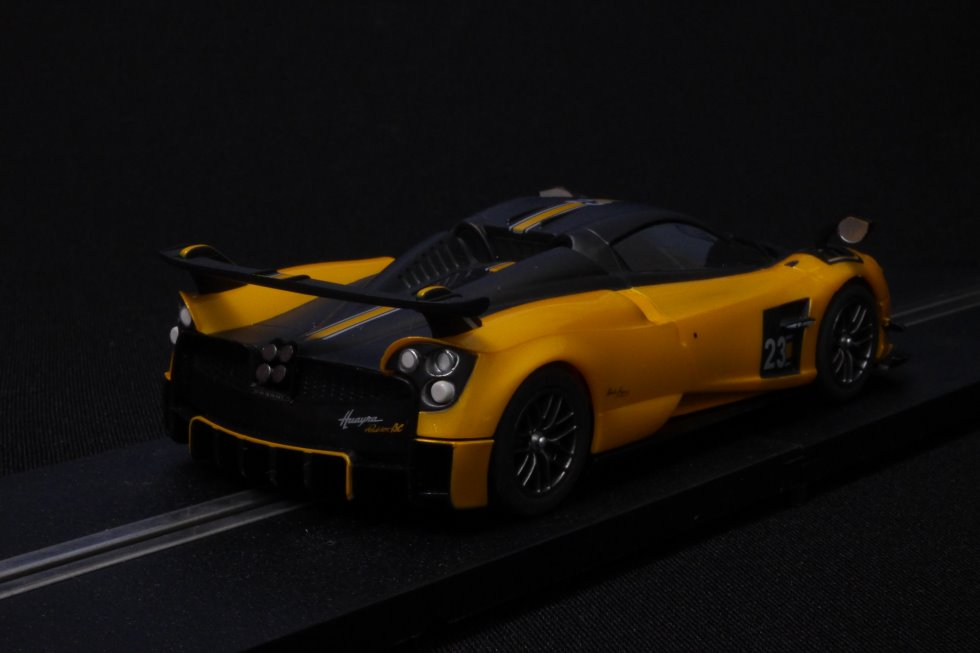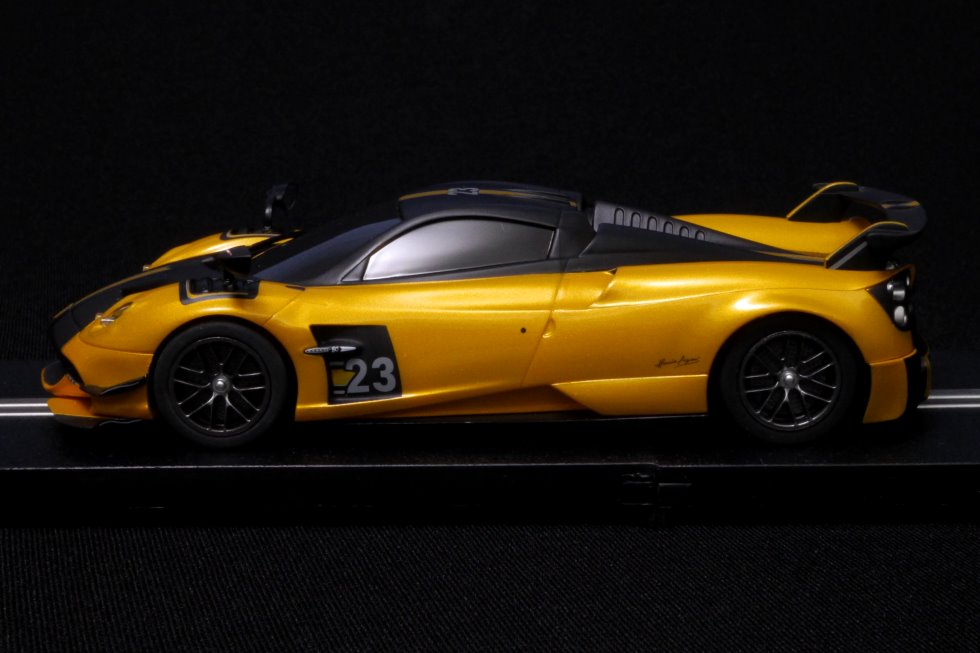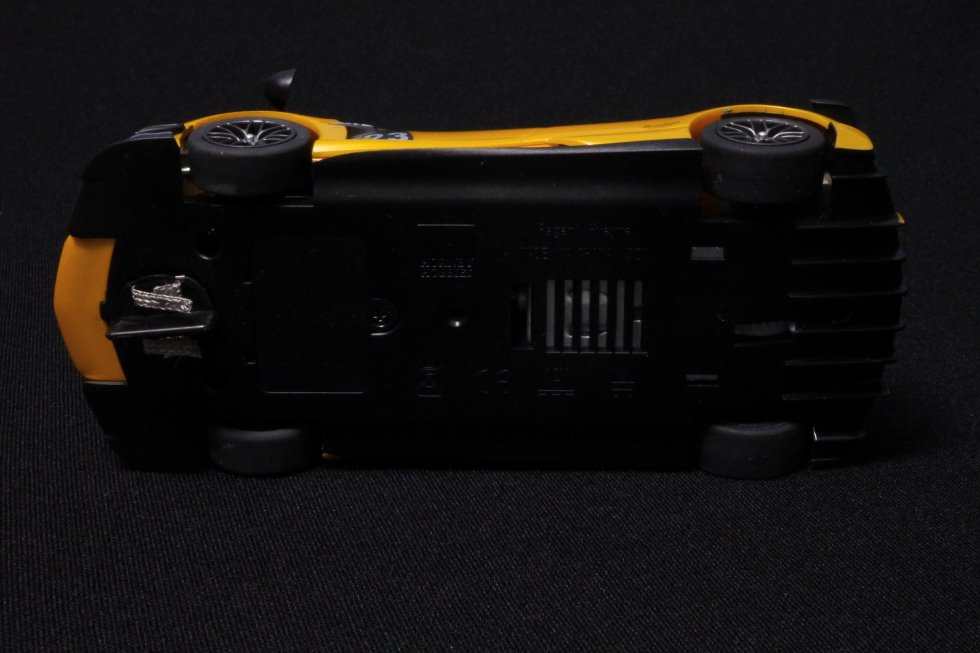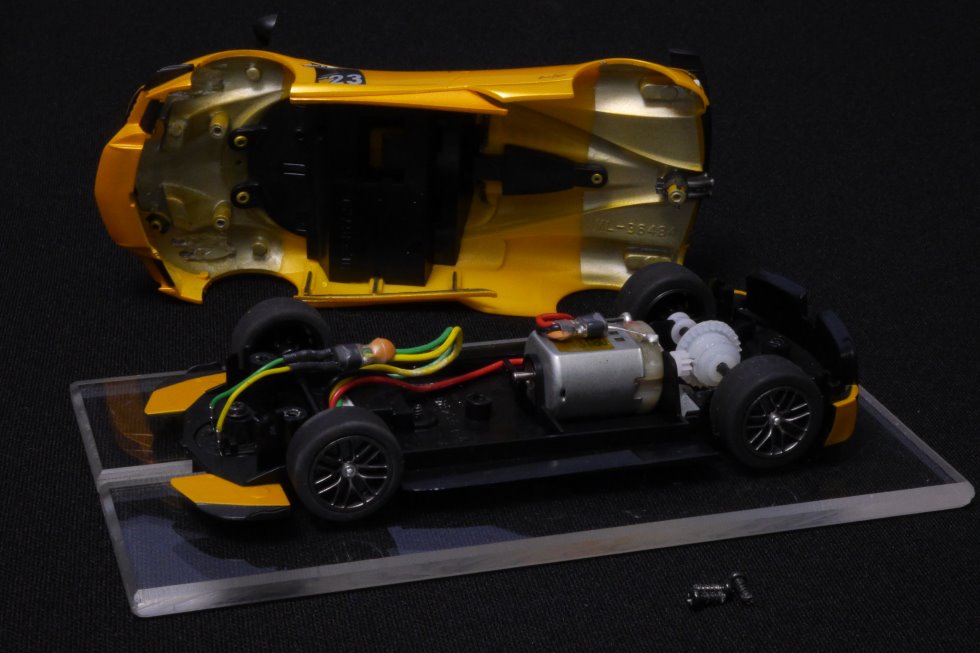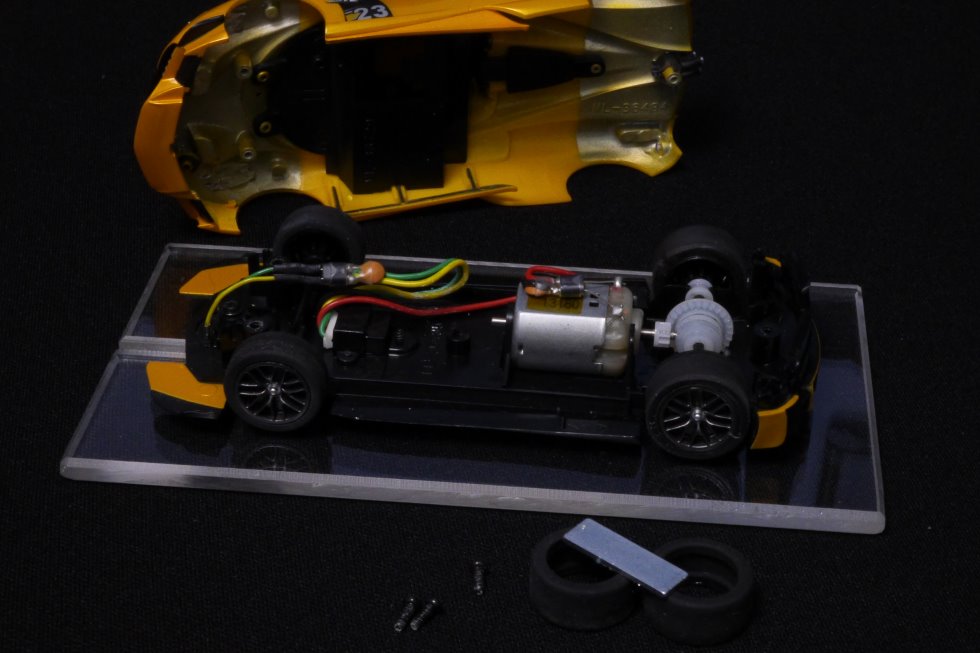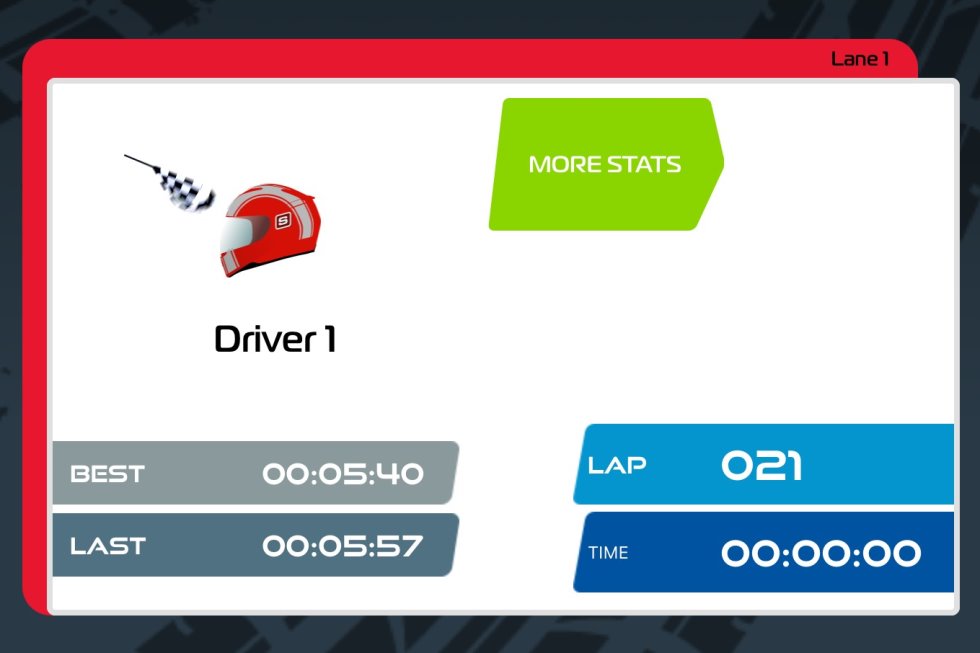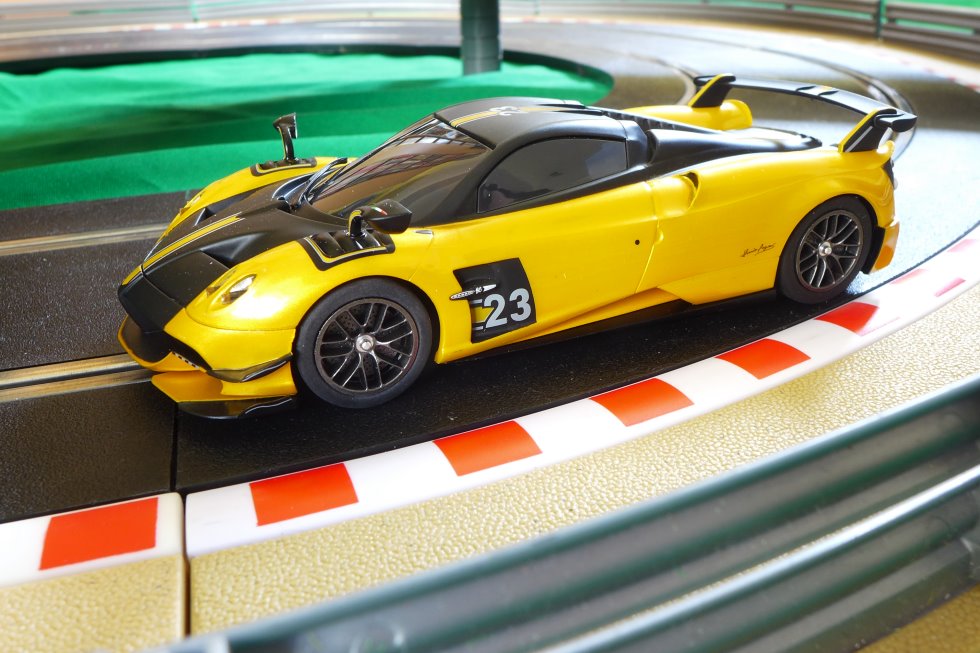You’re going to love Scalextric’s latest hypercar…
There’s a lot to like about the Scalextric Super Resistant hypercar range. Not only are they the closest any of us is likely to get to owning a real hypercar, but they look great, run well and are great-value – ideal track day cars for racers of all ages and abilities. I’m a fan of the cardboard packaging too.
The Huayra Roadster BC is the new hypercar model for 2021. I loved the look of it in the catalogue and the Scalextric team very kindly sent me a pre-production sample to have a look at and take for a spin.
This yellow version is expected soon – end of September or early October – and is available to pre-order here: www.jadlamracingmodels.com/scalextric-slot-car-c4212-pagani-huayra-roadster-bc-yellow/. The purple ‘Drago Viola Edition’ car will be arriving later than planned, but you can still pre-order it: www.jadlamracingmodels.com/scalextric-slot-car-c4248-pagani-huayra-roadster-bc-drago-viola-edition/
The Real Pagani Huayra Roadster BC
The Huayra is a low-volume Italian hypercar – only 100 were produced of the original version, with another hundred Roadsters following in 2017. The BC is a modified track-focused evolution – twenty were manufactured and sold instantly at £2 million each. The total run of Roadster BCs is limited to forty cars. The model’s debut was in June 2019, via the CSR2 racing app – an unusual way to launch a car, but certainly a very large and appreciative audience.
The Roadster BC is powered by a 789 bhp 6-litre twin-turbo Mercedes V12, giving a 0-60 time of 2.2 seconds and a top speed of 238 mph. The monocoque of the roadster is constructed of carbon-titanium HP62 material, making the chassis low weight and rigid. Aerodynamic downforce is aided by an F1-style blown-diffuser – the Roadster BC is claimed to generate a massive 1,102 lbs of downforce at 174 mph. The Pagani Huayra Roadster BC really is the ultimate track day hypercar.
The Scalextric Model
This was love at first sight for me – the Huayra is a very special car. The yellow version looks even better in the flesh than it did in the catalogue. I thought the Drago Viola car was the one to have, but now I’m not so sure… The combination of the gloss metallic yellow – and it’s a really classy deep yellow – against the matt black is stunning. It works with the blacked-out windows too. Maybe the black areas should look a bit more ‘carbon fibre-ish’ – but the matt black is definitely good enough.
There are loads of details around the car – excellent for a model in the super resistant range. The moulding is as intricate as the best high-detail cars – the front and rear profiles are particularly pleasing. The decoration includes tampo printing that I needed a magnifying glass to read – including Horacio Pagani’s signature just in front of the rear wheel arches. The overall finish on my sample car was flawless. One tiny issue was the centre stripe didn’t quite line up on the nose – something I only noticed after viewing the front-on photograph.
The big wing mirrors are flexible, so should withstand some punishment. The windscreen wiper is a separate piece, which is good to see – although does make it vulnerable. The wheels are nicely detailed too – the correct seven double-spoke wheels have grey brake disks showing through and a silver central wheel nut. Finally, the rear wing looks great, but probably won’t last too long. It is stuck very firmly and can’t be loosened from underneath, so won’t be easily removed for racing.
The Mechanical Stuff
Underneath, the Huayra is nice and flat with the usual Scalextric features – in-line motor, DPR and easy-change guide. The wheels look to be the standard ‘Euro’ size, so can be fitted with Slot.it or NSR racing tyres. The Huayra’s rear axle width is nice and wide (61.5mm) and front tyres just touch the surface of my set-up block – both great news for handling. The underpan is Digital Plug Ready (DPR), meaning it can be easily converted to Scalextric digital using the C8515 Digital Plug or to Carrera Digital132 using the Carson digital conversion chip. These super resistant cars make excellent digital cars.
Three screws (two front, one at the back) attach the body to the underpan. When these are removed and the body comes off, you can see much of the rear end stays on the underpan. The body posts on the underpan don’t have a lip round the edge, which is great for creating body float by loosening the screws one turn.
The mechanicals are pretty standard for a modern Scalextric car – tray interior, easy-fit guide, inline short can motor, plus the magnet just in front of the rear axle. On my DIY magnet gauge, the Huayra measured 45g – which is on the higher end of the scale for recent Scalextric releases. As it’s a super resistant model, there are no lights fitted – but there are mounting points for front and rear light boards on the underpan. There’s also a full cockpit behind the blacked-out windows, so a high-detail Huayra remains an option for Scalextric.
Track Performance
The Huayra was fast and lively when I put it on my ARC Air Jadlam SL6 test track. It handled nicely, the back stepping out if I pushed too hard in the corners – I much prefer this to the sudden crash & burn behaviour of some of the super resistant cars. Obviously the magnetic downforce was strong – just like the downforce on the real car – and the tyres had decent grip too. Scuffing the tyres (see Part 2 of my Scalextric Tuning series) would improve that grip even more. Overall, I really enjoyed driving the car round the twisty layout.
When I launched the ARC app and started a two-minute timed run, I thought something was wrong. The trigger felt spongy and I was driving at almost full throttle. Had I left Max Power at 75% from a previous session? It turned out I hadn’t – it was 100% with my usual ‘Profile A’ in the Throttle Curve menu. For the Huayra, this would seem an ideal setting for even a beginner driver – and I managed a massive 29 laps and a blistering 3:77 second best lap!
Wanting a more lively car, I changed the Throttle Curve to ‘Profile C’ – the linear setting that is the default on the powerbase without the app running. This gave me the same feel as before – and I really liked it. The car needed a wider range of trigger movement and was hanging on round the corners, plus I was having to control the occasional tail slide. In two minutes I cracked 30 laps (hurrah!) and bagged a best lap time of 3:78 seconds.
Those runs make the Pagani Huayra Roadster BC the fastest Scalextric car I’ve tested so far on the SL6 layout. The strong magnet certainly helped – and after 5-6 minutes of racing the motor was getting rather hot because of that magnetic drag. The Scalextric team have told me I can test these sample cars without magnets – if I’m very careful – so I opened the car up, took out the magnet and put a pair of NSR5230 Supergrip tyres on the back wheels. I didn’t add any weight, but I did loosen off the body screws a lot to allow some satisfying body float…
Oh my… That was good! Even without any weight, the non-mag handling of the Huayra was surprisingly excellent. It is low and wide, plus has a perfect front axle height – which all help with non-mag running. I dialed the ARC app throttle curve back to Profile A and immediately put in 21 laps, with a best of 5:40 seconds – that’s almost in the territory of non-mag Slot.it, Policar and NSR cars on my SL6 layout. Yes, the NSR tyres helped – the standard Scalextric tyres would need some work to get sufficient levels of grip. There was also some slight understeer, so I wanted to try again with just a little weight in the bottom of the underpan…
So one more run – this time with 2.5g of tungsten putty just in front of the motor. The car definitely felt more stable. I could push more and the ARC app scored 22 laps in 2 minutes, plus a fast time of 5:30 seconds. I told you a little weight would help. When I get my own Huayra, I want it as a non-mag racer. I noticed a bit of ‘hop’ under acceleration, so I shall glue the motor in place. I’ll also fit some copper braids. If you’re interested in non-mag set ups for Scalextric cars, I go through the basics in Part 9 of my Scalextric Tuning series. The Huayra looks a much easier non-mag project than the Mustang.
To sum up, Scalextric have come up with a stunning 1:32 hypercar – the Pagani Huayra Roadster BC looks sensational, goes like a rocket and handles like a dream – plus the price tag is a tad lower than the real thing. This one seems to tick all the boxes – a perfect beginners car, great for digital racing, a remarkably good non-mag racer, eye-catching on display and a cool project car if you wanted to add lights and other gadgets to it. I’ve gone from thinking I might get the Drago Viola model, to pre-ordering this one too – and I’m looking forward with excitement to what new liveries might be in the 2022 catalogue.
Scalextric Pagani Huayra Roadster BC “Yellow” Data Sheet
Catalogue code: C4212
Available here: www.jadlamracingmodels.com/scalextric-slot-car-c4212-pagani-huayra-roadster-bc-yellow/
Range: Scalextric Super Resistant – 1/32 scale / super resistant / Digital Plug Ready (DPR)
Scheduled: September 2021
Spares included: 2 x braid plates with braid fitted
Lights: none
Motor: Scalextric ‘short-can’ – inline orientation.
Gear ratio: 9:27
Length: 148mm
Wheelbase: 87mm
Rear axle width: 61.5mm
Height: 36mm
Weight: 78g (body = 24.5g)
Andy’s downforce gauge: 45g magnetic downforce


